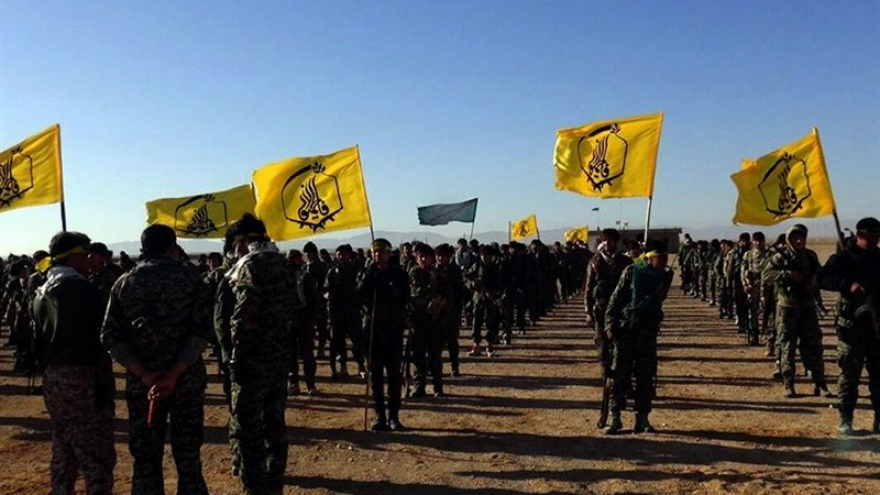Iran has long experience organizing and operating armed militias to promote its interests. During the Bosnian war in the 1990s, thousands of Afghan “alumni” (Mujahideen) arrived in Bosnia to help the local Muslims.
One of the first of these units was established by Iran’s Islamic Revolutionary Guard Corps (IRGC ). It was composed of IRGC commanders and Islamic volunteers, many of whom were Afghan “alumni” and members of Sunni terrorist organizations such as Al-Qaeda, the Egyptian Jamaah al-Islamiyah, the Algerian GIA and others.
The largest of these militias was the force made up of Afghans, known as the Fatemiyoun Brigade, which experts have estimated numbered up to 12,000–15,000 fighters at any one time. Over the years, tens of thousands of Afghans were trained and fought in the ranks of the Fatemiyoun Brigade.
The official purpose of the brigade was to defend the Shi’ite shrines in Syria. Two of the holiest Shi’ite shrines are those dedicated to Sayeda Zeinab and Sayeda Ruqayya, revered religious figures from the family of Imam Ali, one of the four caliphs of Islam and the first Shi’ite imam.
The Fatemiyoun Brigade was established by the IRGC in 2014, and the IRGC commands and manages it. The fighters are mainly Afghan refugees and immigrants recruited from Iran.
Most of those who joined the Fatemiyoun Brigade were from Afghanistan’s ethnic Hazara minority, who are among the country’s poorest. Its operatives are mainly Shi’ite refugees who fled to Iran from Afghanistan. The Iranian government uses coercion and incentives to exploit the Afghans’ vulnerable legal status in Iran and threats of deportation were coupled with high salaries for fighters and permanent residency for their families.
The Afghan recruits were driven mainly by hopelessness and poverty, and the desire to protect the Syrian Shi’ite community and their shrines in Syria.
The Afghan recruits underwent about 30 days of training under the IRGC in Iran’s southern Yazd province. When it was over, they were flown to Damascus, where they opened bank accounts where their salary would be deposited. As fighters for Iran, they could earn the equivalent of $900 a month.
They were taken to the Sayeda Zeinab shrine outside Damascus for final blessings before battle. Then they were taken to the front.
At the end of their service in Syria, they are recalled from the battlefield and allowed a farewell visit to the shrine before their flight back to Iran.
The Fatemiyoun were part of most major battles in Syria, including the retaking of Palmyra and the battles to liberate Deir al-Zour, Abukamal and Aleppo. Thousands died in the war, and hundreds were treated in Iranian hospitals.
After the Iranian declaration of victory in Syria, the Fatemiyoun Brigade released a letter to Iranian Quds Force commander Qasem Soleimani. After expressing readiness to fight Israel, the letter said: “After the complete cleansing of Syria of the presence of takfiri terrorists and ensuring the complete security of the shrines of Zainab and Ruqayya, we hereby announce that, upon orders of Imam Khamenei and under the leadership of Your Excellency, we are ready to step in to support the downtrodden in any corner of the world from where the voice of the oppressed is heard.”
As war in Syria winds down, the question is, what will Iran do with these well trained, well armed and war-hardened forces?
The “Afghan veterans” could be used as a potential global terrorist network. During the years of the war in Syria, Iraq and Afghanistan tens of thousands of Afghan refugees entered Europe. Some of them could be Fatemiyoun Brigade veterans, sent by Iran establish terrorist networks in Europe and elsewhere. The IRGC and Iranian intelligence can send more of them to Europe as refugees or asylum seekers, to collect intelligence and to carry out terrorist attacks.
The brigade is also still operating in Syria—the war is almost over but Iran’s interests in Syria will continue to require some form of military engagement. The Quds Force and its proxy militias will continue to have a role because of the inability of Assad’s forces to secure the country on their own.
Iran also has an interest in maintaining its “land bridge” to Lebanon. The land route starts from Iran’s border with Iraq and runs through Syria to Lebanon, allowing Iran more easily supply and equip its regional allies—Assad in Syria and Hezbollah in Lebanon. The presence of multiple competing hostile forces , including the Syrian Democratic Forces, al-Nusra Front and Ahrar al-Sham , could threaten that land corridor, suggesting a continued need for the Fatemiyoun.
The Fatemiyoun Brigade or sub-units of it might also be deployed to support Iranian allies in other theaters, such as the Houthis in Yemen.
Roughly 10,000 Fatemiyoun veterans have returned to Afghanistan. The Shi’ite mercenaries from Afghanistan’s impoverished Hazara communities are returning to their homeland, where they are met with suspicion and face arrest by security agencies that view them as traitors. Afghan security officials believe Iran is still organizing them and could mobilize these ex-fighters once more to assert its influence in Afghanistan.
Iran is also sending Afghan fighters back to Iran where their families, mostly refugees or undocumented immigrants, have been promised permanent residency. This gives the fighters’ families a secure future, but Iran could transform these ex-fighters into a paramilitary unit that could be activated and deployed when and where needed.
In conclusion, tens of thousands of Afghans were recruited, paid and trained by Iran to fight in support of Tehran’s ally Bashar Assad. On November 21, 2017, Iran declared victory against the Islamic State in Syria. Since Iran’s declaration of victory, there are indications that Fatemiyoun recruitment has stopped and some fighters are being returned to Iran and Afghanistan.
It is not clear if Iran will disband the brigade entirely, however. It may opt to preserve it in some form. But Iran can easily expand the Fatemiyoun as needed since it can recruit from the millions of desperate and legally vulnerable Afghan refugees and immigrants living in Iran.
As it appears from the various Iranian and Hezbollah terrorist plots targeting Europe uncovered in recent years, their apparatuses use a wide range of operatives, including asylum seekers, for intelligence missions or as terrorist infrastructure.
There are hundreds of Iranian Quds Force, Iranian Ministry of Intelligence and Hezbollah members within E.U. borders and elsewhere, many of whom could be activated should Iran or Hezbollah decide to act against E.U., U.S or Israeli targets on European soil.
The veterans of the Fatemiyoun brigade wrote in the letter to the Quds Force commander Qasem Soleimani that “we are ready to step in to support the downtrodden in any corner of the world from where the voice of the oppressed is heard.” The IRGC is aware of the potential of Afghan veterans and could use them to carry out terrorist attacks in Europe and elsewhere.
As the tension between Iran and the United States and its Middle Eastern allies rises, Tehran has launched a campaign of covert military operations after years of relative restraint.
European countries must be alert to the potential threat from Shi’ite jihadists and the radicalization of European Muslim youths by the Iranian Shi’ite revolutionary doctrine. Iran and Hezbollah are the main potential threats to the U.S., Israeli and E.U. interests. This is something not yet realized by Western governments. The E.U. and its member states must understand the need to prevent the Iranian threat to their security and interests and take the necessary tough measures against the Iranian regime and its proxies.
The Iranian terror campaign that was foiled in Europe in 2018–2019 and the recent attacks against the oil tankers in UAE and against Saudi oil infrastructure highlighted the need for the international community to act decisively to confront Iran and all terrorist organizations supported by Iran, in order to maintain regional and international peace and security.
Shaul Shay is a senior research fellow at the International Institute for Counter-Terrorism (ICT) at the Interdisciplinary Center Herzliya (IDC) and former deputy head of Israel’s National Security Council.


























